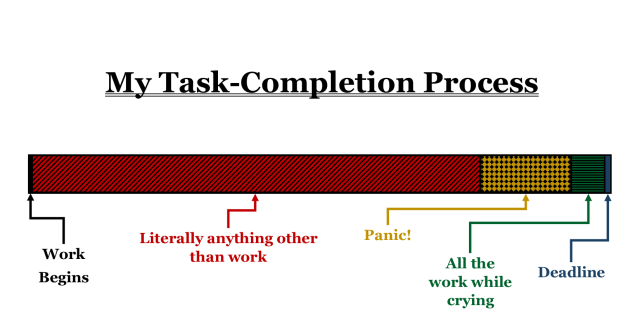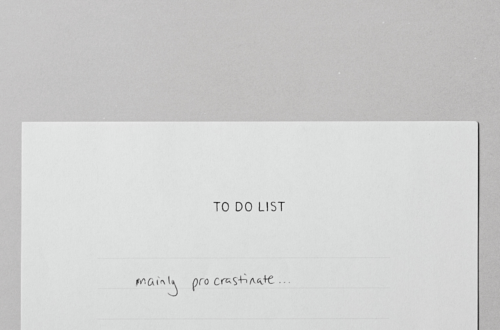
Someday, But Not This Day: The Life of a Serial Procrastinator
Procrastination is a popular topic for self-help gurus. Lately, it seems like everywhere I look, there’s a new book or blog post or TED Talk dedicated to tackling the procrastination problem once and for all. The other day, I made the mistake of saving a spoof anti-procrastination motivational quote on Pinterest. “Why put off until tomorrow what you could get done today?!” Adages like this now populate my feed. They warn me that “procrastination is the enemy of success!” They admonish me that “a person who really wants something will find a way…a person who does not will find an excuse.”
I find adages like these to be simplistic and, in truth, rather dismissive. The last one, especially, presumes that those who procrastinate are not trying hard enough or are just lazy. (I also take issue with the implication that everyone should strive to be as productive as possible. Those who don’t conform to this ideal are not somehow lesser than their success-oriented counterparts, but that is beside the point.) This, in my opinion, is simply wrong the majority of the time. My tendency to procrastinate is not without purpose. It’s not because I’m lazy or trying to make excuses. It’s because making decisions, a lot of the time, is incredibly overwhelming. Procrastination is a tool for allaying the stress and anxiety that accompany decision-making.
Procrastination & Decision-Making
In fact, avoidance and procrastination have been tools I use to deal with mentally difficult tasks for a pretty long time. Graduate school was a particularly tough time for me as far as avoidance was concerned. My nasty habit: I put off doing things until the last possible minute. I simply had too many thoughts to sort out. Deciding how to do so was extremely difficult, so I avoided facing those decisions for as long as I could.
The harder the work got, the worse my avoidance and procrastination. It was so bad, I even nicknamed myself Last-Minute Lori. I wrote pretty much every term paper the night before (because, who didn’t, right?). I also wrote the entire Discussion section of my master’s thesis in the two days before the deadline. (For those who don’t know, the Discussion is where you explain the results of your research in plain English.)
It didn’t stop there. When my comprehensive exam (an extremely detailed paper that reviews the published scientific research on a particular topic) rolled around, I ended up waiting until the week of the deadline. (You must pass the exam to be allowed to write a dissertation at all.) Indecision incapacitated me. Then I spent all day, every day holed up in my basement office in the Psychology building. I threw back cups of coffee and hammered away at my laptop keyboard. I worked until so late you couldn’t consider it to be nighttime anymore. (Somehow I passed with flying colors, though, which did not exactly discourage me from continuing to procrastinate on important projects.)
By the time I got around to my dissertation, I was entrenched in my toxic avoidance pattern . The department’s deadlines came and went without my document being anywhere close to finished. My document remained untouched since my proposal meeting. The only motivator strong enough to propel me to the finish line was a threat from the Graduate School. I would forfeit my eligibility to complete the project without a special waiver if I didn’t finish that year. (Doing so would equate, in essence, to nullifying and flushing all my work up to that point down the toilet.) I wrote a few panicked emails to the registrar: Was the summer semester was included in the eligibility window? (It was!) And, even so, I was still polishing off my document the day it was due to my dissertation committee members. Yikes!
The Procrastination Pattern
Over and over and over again, I repeated the same pattern:
- Delay working on the task as long as possible.
- Look at the clock and realize that, if I don’t start now, I won’t finish in time.
- Mentally collapse into complete and utter panic.
- Become so completely overwhelmed that a full-on meltdown ensues, complete with sobbing, headache, and nausea, and culminating in exhaustion.
- Say “screw it” to myself, give up caring about the quality of the final product, crank it out in a ridiculously short about of time, and dub it “good enough.”
Or, in pictorial form:

A Lifetime of Procrastination
As I think back, I see harbingers of my struggle with procrastination spanning at least the last 25 years of my life. I recall once needing to stay home from elementary school to read a whole book for a book report. In middle school and early high school, I put off a few papers/projects for so long my mom ended up “helping” me (thanks mom!). (To this day, I still know nothing about Eleanor of Aquitaine or Rachel Carson’s Silent Spring. I “wrote” lengthy reports on both.) My procrastination habit persisted in college, too. I had to clean my entire dorm room before I could start working on a project. I also think nearly every paper I composed was an all-nighter.
This pattern of avoiding difficult decisions and tasks has leeched into other areas of my life as well. I always mean to do a thorough house cleaning before guests come over. Typically, I end up scrambling to pick up discarded toys and hiding clutter away in the hour before the guests are supposed to arrive. Clutter moves from surface to surface indefinitely. It’s simply too difficult to figure out where its permanent home should be. My “to-do” list is miles long, and yet I tick off very few, if any, boxes each day. And who knows if I will ever hang any artwork on the bare walls in our house. Why?
Decision Paralysis
The answer: these things all require me to make decisions. Decision-making can be extremely stressful, even paralyzing, for someone like me who wrestles with anxiety. So I avoid making those decisions like I would avoid the plague, and it works. Avoidance is actually a very effective anxiety relief technique.
Until it isn’t anymore…
Inevitably, at some point, most delayed decisions have to be made, and most avoided tasks have to be tackled. There is only so long I can add to that pile of crap on the stairs before it becomes difficult (not to mention dangerous) to walk past. Tables and countertops can only accumulate so much clutter before it drives me insane. I can only neglect to work on a project before I become a failure.
Two Approaches to Tackling Tasks
As I see it, there are two primary approaches to overcome inertia, stop procrastinating, and get to work on whatever task is at hand. Getting started on a task is a lot like getting into a frigid swimming pool, so I call these two methods the cannon ball and the toe-dip. Cannon ball people prefer to jump right in, exposing their entire bodies to the icy water all at once. These people like to attack the hardest task first. They get it out of the way so the remainder of their tasks become progressively easier. I am not a cannon ball person. This approach will never, and I mean NEVER, work for me (so don’t even suggest it!). Increasingly difficult tasks cause me increasingly intense anxiety, which results in increasing levels of task paralysis.*
The only way I can accomplish difficult tasks is via the toe-dip method. I gradually ease my way into the shiver-inducing pool. I have to start with something easy to do, requiring very little effort, minimal thinking, and necessitating few, if any, decisions. For example, I just turn on the computer. Then I just open my dissertation document. I just read what I’ve already written in the last section. Then, and only then, can I move forward with a task; it’s just too daunting otherwise. Complex, difficult tasks make my mind hurt** There are so many different ways to proceed. There are too many paths from which to choose.
The toe-dip method is a form of behavioral activation (to use the fancy-schmancy psychological term). Behavioral activation, not surprisingly, has its origins in the behavioral arm of Cognitive Behavioral Therapy (CBT). It is now a therapeutic technique in its own right, and it’s often used especially to treat anxiety and depression. In clients with depression, for example, a therapist might ask the clients to engage in an activity they used to enjoy (e.g., playing the piano, going for a run, reading a book) for only five minutes (or three minutes, or one minute, if five minutes is too difficult—the amount of time is not the important part). If, after the time has elapsed, the clients want to stop, then they are allowed to stop. After all, anyone can read a book for just five minutes, right?
Many of us mistakenly believe we need to have the desire to do a particular activity before we start doing it. But, in reality, we often don’t feel the desire to do the activity until we have already started doing it. We don’t feel like exercising until we’re already exercising; I don’t feel like writing until I’m already writing. Inevitably, opening my dissertation document would lead to me reading what I had already written. Doing so would lead to me tweaking some wording here and there. Editing would lead to some new thoughts to write down. And then, just like that, I was writing!
I used a similar tactic when I was skating (as I mentioned in my previous post on performance anxiety). I “dipped my toe” into the performance by starting with an easy element—a spin or a jump I could perform in my sleep. This would build my confidence before I moved on to attempt the harder ones. It was only by starting the process with an action I could perform without thinking that I was ever able to settle into the rest of the performance.
The Takeaway
For me, not thinking is the key. When I think about a task, I think about how I feel. And when I think about how I feel, more often than not I become overwhelmed. And when I become overwhelmed, well…you can guess where this is going (procrastination!).
I came up with a saying, or a mantra (if you will), to remind me to use the behavioral activation method whenever I am struggling to accomplish a task. It works whether it’s something as weighty as a dissertation or something as seemingly trivial as figuring out how to organize a blog post about procrastination (wink wink). If you, like me, cringe at the idea of doing a cannon ball into the bone-chilling pool of your “to-do” list, I leave you with one final thought:
Don’t think; just do.
Notes:
*Don’t even get me started on telling other people how to solve their problems. This is probably a topic for another post entirely (edit: I wrote one, and you can find it here). But, suffice it to say: don’t. Just don’t. We are all smart enough to figure out possible solutions to our problems. And, unless we explicitly ask for outside opinions on how to resolve them, we seek understanding and empathy—not solutions—from our confidants. Most of us rely on friends and family to help us process the emotions we feel in problematic situations. Once we do that, we can move on to enacting (our own) solutions.
**Some studies have shown that the same areas of the brain involved in processing and feeling physical pain are also involved in processing and feeling emotional pain (summarized in this article from Psychology Today). Depression and anxiety really can hurt just as much as dropping a hammer on your foot. The neurological underpinnings for both types of pain are largely the same.







7 Comments
Emily Borsa
Well this made me feel entirely better about all of my procrastination in high school, college and grad school. I also am a last minute person. Lots of asking for extra time, lots of late nights, and surprisingly passing my classes. I didn’t always get A’s, but imagine if I spent the time and tried harder. I would have been a much better student. BUT, I simply don’t function that way. I work better under stress. Otherwise I am BORED out of my mind. Housework? What housework? This is one area that I do wish I was better at. I avoid feeling uncomfortable at all costs and cleaning makes me uncomfortable. I only want to feel good, and reading in bed feels good. Not ideal, but that is how it is. And “don’t think; just do” is something my own therapist has said to me many times. Don’t think about why you don’t want to do a task, just do it. And start small. I have anxiety and depression so big picture thinking stresses me out. I am learning a lot this year in particular that everything takes time and takes small steps. I just have to keep working on the “just do” part of it all.
K E Garland
This is my daughter. We’re at opposite ends of the spectrum. Waiting until the very last minute to accomplish a task would send me into a horrible space and it wouldn’t get done. Reading about your experiences has actually helped me understand her a little bit, so thanks for that.
Also, this part “and unless we explicitly ask for outside opinions on how to resolve them, we seek understanding and empathy—not solutions—from those in whom we choose to confide” is something I wished people would understand.
Lori
That last part is actually going to be the topic for my next post!
caita08
I relate so much to this post! I am also a procrastinator and will never be able to do the “cannonball” approach. I definitely also think I need to wait until I want to work on something… which never happens. I’m going to try and implement the “toe-dip” strategy when I start graduate school in the fall. Definitely adding “Don’t think; just do” to my mantra repertoire!
Caitlin
I relate to this so much! I am a huge procrastinator with school work and cleaning in particular. I’m definitely going to add the “don’t think; just do” mantra to my repertoire!
Pingback:
Pingback: